Domestic abuse: statistics recorded by the police in Scotland - 2017/18
Characteristics of victims and perpetrators of domestic abuse incidents recorded by the police in Scotland.
This document is part of a collection
3. Main Findings: Incidents of Domestic Abuse in Scotland
Incidents of Domestic Abuse
3.1 Levels of domestic abuse recorded by the police in Scotland have remained relatively stable since 2011-12, with around 58,000 to 60,000 incidents a year. The police recorded 59,541 incidents of domestic abuse in 2017-18, an increase of 1% compared to the previous year (Chart 1 & Table 1).
Of the 59,541 incidents of domestic abuse recorded by the police in 2017-18, 44% (26,273) included the recording of at least one crime or offence (compared to 47% in 2016-17) (Table 1 & Chart 1). The remaining 56% (33,268) did not include the recording of a crime or offence.
Incidents which included a crime or offence
For those domestic abuse incidents that included the recording of at least one crime or offence in 2017-18, the most frequently recorded was Common assault (accounting for 37% of all crimes and offences). This was followed by Breach of the peace etc. which accounted for 31% of crimes and offences (Table 2).
Chart 1: Incidents of domestic abuse recorded by the police, 2008-09 to 2017-18 *
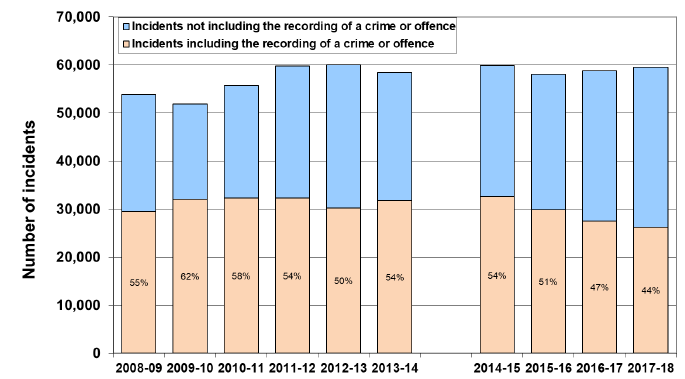
* Chart has been displayed with a gap in the time series to highlight the changes in data collection. See Section 6.4 for more details.
Incidents which did not include a crime or offence
3.2 In 2017-18, 56% of domestic abuse incidents within the interim Vulnerable Persons Database (iVPD) did not include the recording of at least one crime or offence. This reflects that the definition of domestic abuse used by Police Scotland is not restricted to behaviour where criminal conduct has been identified and recorded. This also reflects that the iVPD aims to collate disparate pieces of information about incidents into a single file, allowing officers to build a narrative about people who have reported or been involved in an incident with a potential domestic abuse element. The iVPD itself is not a crime recording system.
Further information into Incidents which did not include a crime or offence
3.3 Last year, Scottish Government statisticians reviewed a sample of those domestic abuse incidents that did not include the recording of at least one crime or offence. This was to provide users with additional information on the circumstances of these incidents.
Four hundred incidents from 2016-17 were randomly selected from the iVPD and a synopsis of each case was recorded. The findings of this exercise are again presented below, and should be treated as a broad indication of the characteristics of those domestic abuse incidents which don’t include a crime or offence, rather than an exact measure (given the associated possibility of sampling error and wide range of behaviours covered).
Summary of Incidents that exclude the recording of a Crime or Offence
3.4 Around half of these incidents (52%) in 2016-17 were based on some form of argument between partners or ex-partners that excluded any reference to a physical confrontation or threatening behaviour. Of these specific cases, around two-thirds include one of the partners/ex-partners contacting the police, whilst in around 30% of cases a third party or other witness did so. A quarter of cases that refer to some form of argument include one of the parties contacting the police as they wanted the other person to leave.
Around a fifth of these incidents (19%) were based on concern about the communication or attempted communication of one partner/ex-partner towards the other (excluding any reference to an argument or a specific crime or offence). In almost all these cases it was one of the partners/ex-partners that contacted the police. This involved a range of different incidents, including frequent references to unwanted communication or attempted communication, which could be through electronic means (text-messages, phone calls etc.) or in person. This category also includes incidents where one party is concerned about what their partner/ex-partner has said about them (sometimes to third parties).
Beyond the incidents described above, the other cases cover a diverse range of situations. Some included the police being contacted for advice or an individual raising concerns without reference to any specific incident (7% of the sample). In some instances the police were contacted by one partner/ex-partner out of concern for the well-being of the other party (3%) or by someone wishing to retrieve their belongings from a partner/ex-partner (3%).
Finally, some incidents recorded in the iVPD in 2016-17 were best described as situations in which it is inferred that a crime or offence may have taken place (13% of the sample). In most of these cases (11% of the sample) further investigation determined either that a crime or offence had not occurred (for example by the police reviewing the content of text messages that were alleged to be threatening) or there was insufficient evidence for the police to record a crime or offence. In the other cases (2% of the sample), further discussion with Police Scotland determined that these incidents did include a crime or offence. This splits into cases where a crime or offence had been recorded in Crime Management systems but not added to the iVPD or where no crime or offence had been recorded at all.
Local Authority Analysis
3.5 Changes in the number of domestic abuse incidents recorded by the police between 2016-17 and 2017-18 were varied at the local authority level (Table 3). Just over half (17) recorded an increase in domestic abuse whereas 14 recorded a decrease and one was unchanged.
In 2017-18, the highest percentage of incidents of domestic abuse that included the recording of at least one crime or offence also being recorded was in Dumfries & Galloway (61%) and Moray (58%) (Chart 2 & Table 4).
Incidents of Domestic Abuse per 10,000 Population
3.6 Taking the population of Scotland as at mid-year 2017, there were 110 recorded incidents of domestic abuse per 10,000 population in 2017-18. At a local authority level, Clackmannanshire (162) and West Dunbartonshire (153) recorded the highest incident rates per 10,000 population. The Orkney Islands (49) and East Dunbartonshire (52) recorded the lowest rates per 10,000 population (Chart 3 & Table 5).
Victim & Accused Characteristics
3.7 Where the victim’s gender was known, the clear majority of victims in 2017-18 (82%) were female. Around four out of every five incidents of domestic abuse in 2017-18 had a female victim and a male accused. This proportion has remained very stable since 2011-12.
Again, where the victim’s gender was known, 18% of victims in 2017-18 were male. In 2017-18, 16% of domestic abuse incidents involved a male victim and a female accused. Again, this proportion has remained stable since 2011-12 (ranging from 16% to 18%) (Chart 4 & Table 6).
Relationship between Victim & Accused
3.8 In 2017-18, over half (52%) of domestic abuse incidents (where the relationship between the victim and accused is known) were between current partners. Of the remaining incidents, 47% involved ex-partners (Table 7).
Chart 2: Percentage of incidents of domestic abuse recorded by the police that included at least one crime or offence being recorded, by local authority, 2017-18
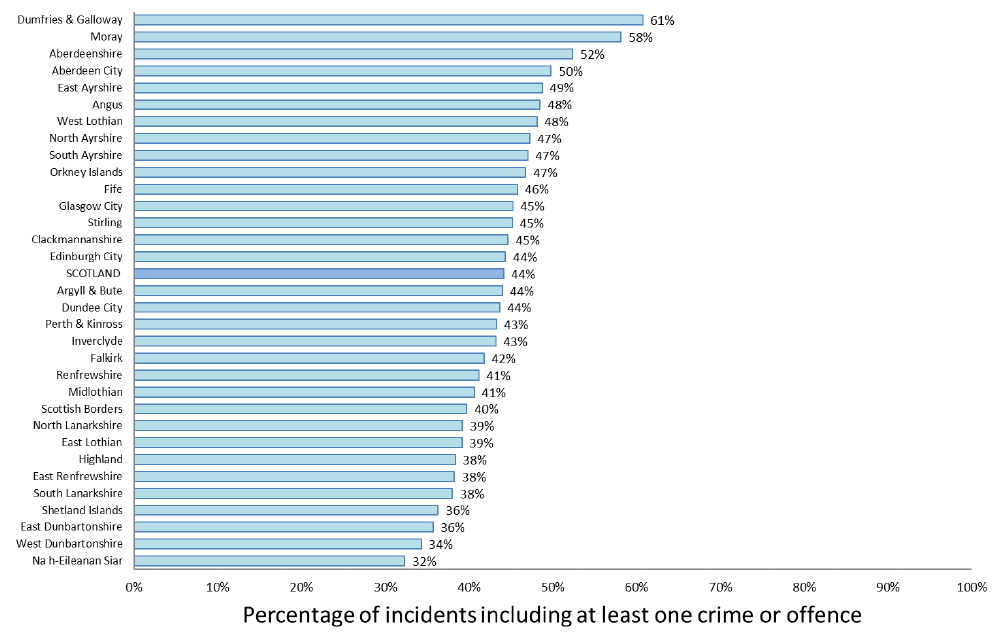
Chart 3: Incidents of domestic abuse recorded by the police per 10,000 population1, by local authority, 2017-18
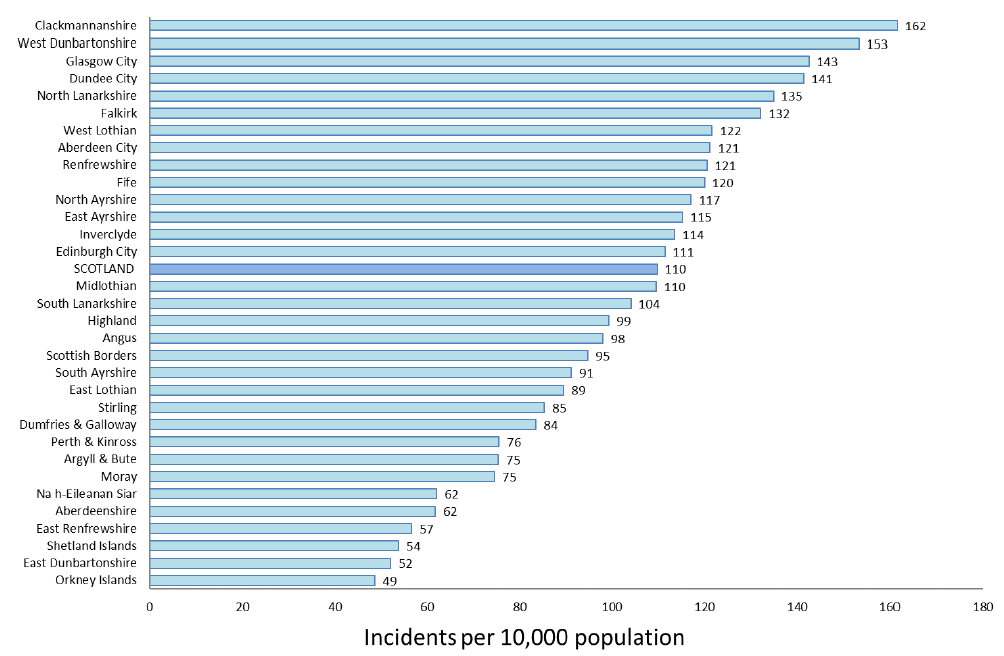
1. Population estimates are at mid-year 2016 published by the National Records of Scotland (http://www.nrscotland.gov.uk/statistics-and-data/statistics/statistics-by-theme/population/population-estimates/mid-year-population-estimates)
Chart 4: Gender of victim and accused, where known, 2008-09 to 2017-18
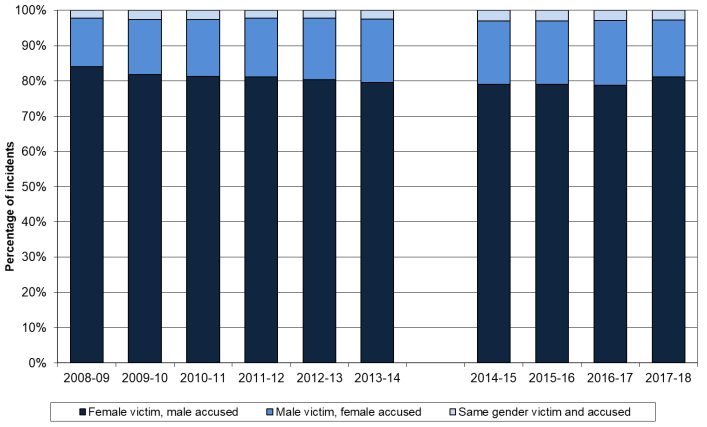
* Chart has been displayed with a gap in the time series to highlight the changes in data collection. See Section 6.4 for more details.
* Chart only displays incidents where gender of victim and accused is known. See Section 6.18 for more details on missing data.
3.9 In 2017-18, the 26 to 30 year old age group had the highest rate per 10,000 population for both victims (272 incidents recorded per 10,000 population) and those accused (246 incidents recorded per 10,000 population) (Table 8 & Table 9).
In 2017-18, female victims aged 26 to 30 had the highest rate (455) of incidents of domestic abuse recorded by the police per 10,000 population. Among male victims, the highest rate of incidents of domestic abuse recorded per 10,000 population, was for those aged 31 to 35 years, where the rate was 88 incidents recorded per 10,000 population (Chart 5 & Table 8).
In 2017-18, the 26 to 30 year old age group had the highest rate of domestic abuse among both male accused (415 incidents recorded per 10,000 population and female accused (79 incidents recorded per 10,000 population) (Chart 5 & Table 9).
Chart 5: Gender of victim and accused, where known, 2017-18
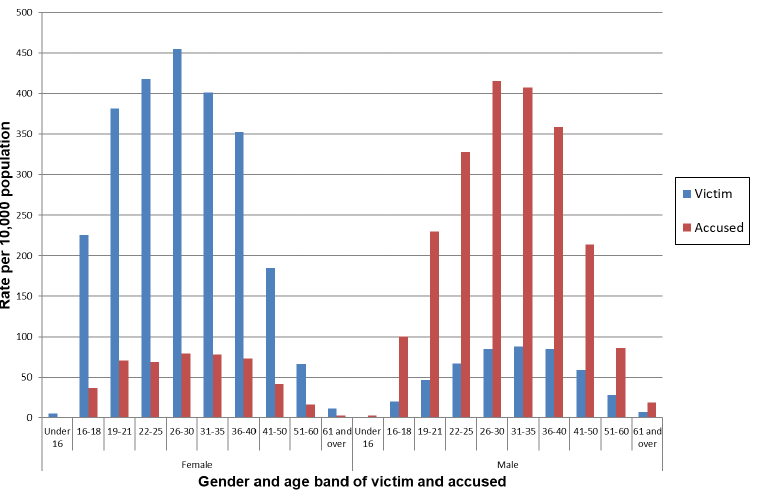
Victim & Accused Repeat Analysis
3.10 The interim Vulnerable Persons Database (iVPD) database (referred to in Paragraph 2.5) enables the identification of a victim or accused that has previously been entered into the system for domestic abuse. A victim or accused can appear multiple times in the database in any one year, each classified as a separate incident.
The iVPD was introduced and rolled out across the then 14 police divisions during 2013-14. Therefore, the first and any subsequent reference to any victim or accused in the repeat categories below only refers to whether they were involved in an incident of domestic abuse from 2013-14 (part year depending on divisional roll-out) and not in any years prior to the introduction of the iVPD.
In 2017-18, 17% (10,228) of domestic abuse incidents did not include sufficient information to confirm one way or the other whether at least one of either the victim or accused had previously been recorded in an incident of domestic abuse. For 54% (26,826) of the remaining 49,313 incidents, both the victim and accused had previously been recorded in an incident of domestic abuse, though not necessarily in the same relationship in all incidents. For 34% (16,933) of incidents, neither the victim nor the accused were found on the iVPD and in 11% (5,554) incidents there was a mix of results for the victim and accused (i.e. only one of the victim or accused had previously been recorded (Table 10 & Chart 6).
Chart 6: Incidents of domestic abuse recorded by the police, by repeat victim/accused analysis (where known), 2017-18
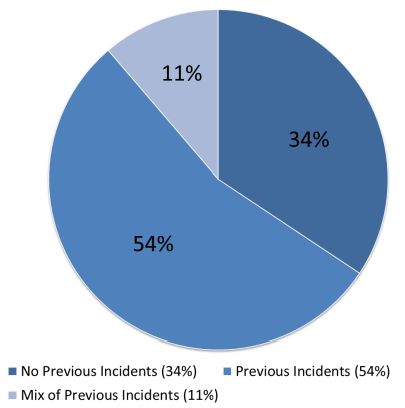
Location of Incidents
3.11 In 2017-18, 88% of incidents occurred in a home or dwelling. This can be further split into 40% of incidents of domestic abuse that occurred within the victim’s own home and 19% that occurred within a joint home. A further 5% occurred in the accused’s home while 24% occurred in an ‘other dwelling’.
The remaining 12% of incidents occurred in the street (6%), licensed premises (1%) or an ‘Other’ location (5%) (Table 11 & Chart 7).
Chart 7: Incidents of domestic abuse recorded by the police, by location, 2017-18
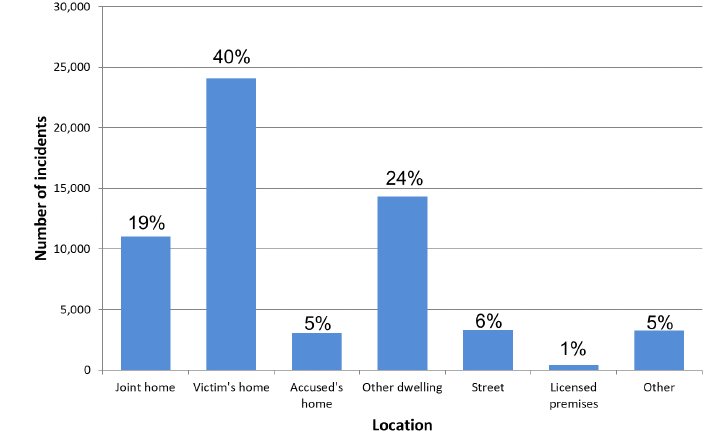
Day/Month of Occurrence
3.12 The following section is based on the date the incident of domestic abuse occurred, rather than when it was recorded by the police.
Incidents of domestic abuse recorded by the police in Scotland are more likely to occur at the weekend with 35% of incidents in 2017-18 occurring on a Saturday or a Sunday. The remaining 65% is spread fairly evenly from Monday to Friday. Over the past ten years the percentage of incidents that occurred at the weekend has fallen from 39% in 2008-09 to 35% in 2017-18.
Chart 8: Incidents of domestic abuse recorded by the police, by day of the week incident occurred, 2017-18
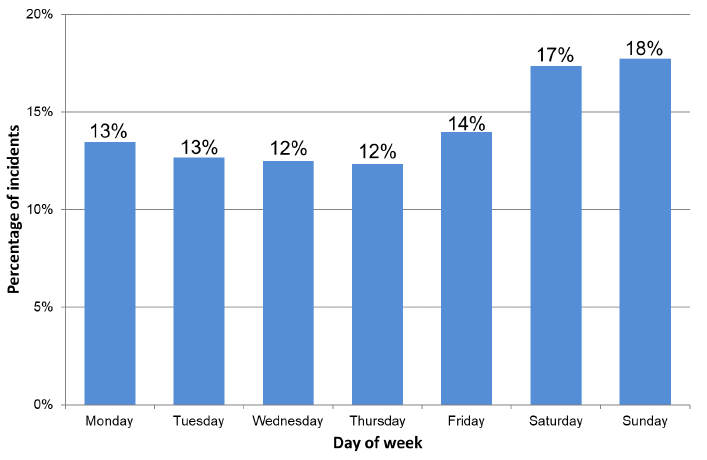
When looking at the month that incidents of domestic abuse recorded by the police occurred in 2017-18, no clear pattern emerges from the data, with incidents reasonably spread out across the year.
Tables for Day/Month are available online: http://www.gov.scot/Topics/Statistics/Browse/Crime-Justice/PubDomesticAbuse
Contact
Email: Mark Bell
There is a problem
Thanks for your feedback